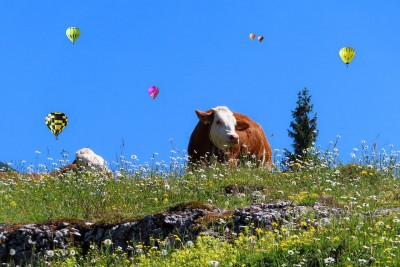Managing Heat Stress by Paul Beck

Managing Heat Stress
Paul Beck, Oklahoma State University Extension Beef Nutrition Specialist
We have had some variations in weather this spring with hot weather and intermittent stretches of cooler temperatures when storm fronts come through. The cooler temperatures are welcome, but they keep livestock from acclimatizing to hot temperatures, increasing the heat stress when hotter temperatures return.
In hot summer conditions, heat transfer failures cause accumulation of body heat resulting in heat stress, reduced performance, animal discomfort, or death. When animals experience discomfort from heat stress, their behaviors change to reduce heat load (increased water consumption, decreased feed intake, seeking shade, standing in water, etc.).
Water intake per unit of feed intake is twice as high during the summer than in the winter. Evaporation of moisture from the respiratory tract through panting is an important way for the animal to lose excess heat load. So, during heat stress water space availability becomes very important. During heat stress the linear water space increases from about 1 inch per head to 3 inches per head to allow for sufficient access to water.
Shade has been found to be beneficial to feedlot cattle, the greatest benefit of shade for finishing cattle is at the onset of the heat stress event. Cattle with shade have lower respiration rates and body temperatures when temperatures increase. Under heat stress, shaded finishing cattle in feedlots have increased average daily gain, hot carcass weights and dressing percentage as well as improved feed efficiency.
Cattle require 1.8 to 9.6 square yards per head depending on the size of the animal. Effective shade structure design depends on the thermal properties of the shade material, the ground cover under the shade, height of the structure, the amount of shade provided per animal, the level of ventilation (lower ventilation can trap heat under the structure), and the orientation of the structure. Shade structures should be at least 12 feet high to reduce direct solar radiation and increase air movement in the shelter. Metal shades effectively block direct solar radiation, but it can accumulate heat and radiate it on the animal. Shade cloth allows more air movement and heat dissipation.
Providing shade, if designed correctly, is an effective strategy to reduce heat load by reducing heat accumulation from direct solar radiation and has animal welfare benefits that can improve performance.
Dr David Lalman provides tips for producers on preventing heat stress in cattle from a classic Sun Up TV episode https://www.youtube.com/watch?v=daseqzNMAi0 from August 4, 2012.
Upcoming Events
IPM Strategies to Protect Corn and Soybean Seed in NY
July 30, 2025
Hamburg , NY
SWNYDLFC and Cornell IPM are hosting a grower meeting to discuss integrated pest management strategies for protecting corn and soybean seed in New York.
FAMACHA Training for Sheep and Goat producers in Woodhull NY
August 13, 2025 : FAMACHA Training in Woodhull
Woodhull, NY
Join us for a discussion and hands-on training for internal parasite integrated pest management in sheep and goats. Certification is available to all students participating in the workshop.
Cover Crop & Soil Health Field Day
August 13, 2025
Andover, NY
Please join us for a morning of hands-on learning with expert insights from local farmers, industry representatives, and extension. We will have some demonstration plots in action along with discussion about how cover crops influence soils and demonstration showing impacts on farm resiliency.
Announcements
No announcements at this time.





